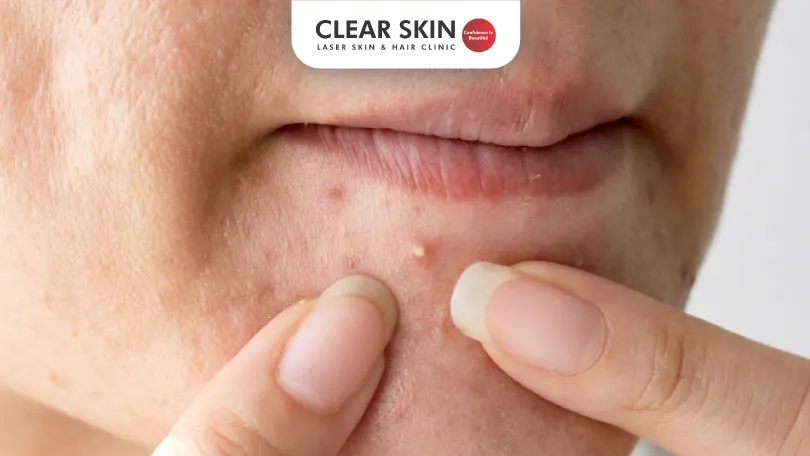White Acne on Face: Causes, Types, and Effective Treatment

Written by Clear Skin Content Team | Medically Reviewed by Dr. Dhanraj Chavan on May 28, 2022

White acne on the face can be a source of frustration and embarrassment for many individuals. These small white bumps on the face, also known as whiteheads, milia, or pustules, can affect one’s self-esteem and overall skin health. In this article, we will explore what white acne on the face is, its causes, various types, identification, treatment options, and prevention strategies.
Table Of Content
- What Is White Acne on Face?
- What are Causes of White Acne on Face
- What are Types of White Acne on Face
- How to Identify White Acne on Face
- Treatment Options
- Prevention Tips for White Acne on Face?
- Conclusion
What Is White Acne on Face?
White acne on the face, often referred to as whiteheads, is a common type of acne that appears as small, raised, white or flesh-colored bumps on the skin. These bumps are typically filled with a mixture of oil and dead skin cells. They can occur anywhere on the face, including the forehead, cheeks, chin, and nose.
What are Causes of White Acne on Face?
1. Excess Sebum Production
One of the primary causes of white acne on the face is an overproduction of sebum, the skin’s natural oil. When sebum production goes into overdrive, it can mix with dead skin cells and clog hair follicles, leading to whiteheads.
2. Clogged Pores
Clogged pores, a result of the accumulation of dead skin cells and sebum, can create the ideal environment for whiteheads to develop. When the pores become blocked, it becomes difficult for the accumulated material to escape.
3. Bacterial Infections
Bacterial infections can exacerbate white acne on the face. When bacteria enter clogged pores, they can cause inflammation and pus formation, leading to pustules.
4. Hormonal Changes
Hormonal fluctuations, particularly during adolescence, pregnancy, or the menstrual cycle, can increase sebum production, making individuals more susceptible to white acne.
What are Types of White Acne on Face?
1. Whiteheads
Whiteheads are non-inflammatory acne lesions characterized by closed, small bumps on the skin’s surface. They are filled with sebum and dead skin cells.
2. Milia
Milia are tiny, dome-shaped, white or yellowish cysts that often appear on the cheeks and under the eyes. They are usually painless but can be persistent.
3. Pustules
Pustules are inflamed white acne bumps with a red base. They contain pus and are often painful.
How to Identify White Acne on Face?
Identifying white acne is relatively simple. Identifying white acne is relatively simple, but it is essential to let your dermatologist determine whether it is acne, milia, syringoma, or another skin condition. While acne is typically painless, pustules, a type of acne lesion, can be painful. It is crucial to distinguish between various skin issues, and your dermatologist is the qualified professional to make an accurate diagnosis.
Treatment Options
Dealing with white acne on the face requires a tailored approach. Here are some treatment options:
1. Home Remedies
While home remedies can provide relief for acne, consulting and seeking advice from a qualified dermatologist is crucial for addressing the issue in the long run. Dermatologists possess specialised knowledge and expertise in skin health, allowing them to assess individual skin types and prescribe tailored treatments that target the root causes of acne.
2. Over-the-Counter Products
Over-the-counter treatments can help with mild cases of white acne. Look for products with ingredients which can unclog pores.
3. Prescription Medications
For severe cases, a dermatologist may prescribe topical or oral medications such as retinoids or antibiotics.
Prevention Tips for White Acne on Face?
To prevent white acne on the face, follow these tips:
- Maintain a consistent skincare routine.
- Avoid squeezing or picking at whiteheads.
- Use oil-free, non-comedogenic makeup and skincare products.
- Keep your hands and phone screen clean.
White acne on the face, including whiteheads, milia, and pustules, can be a frustrating skin condition. Understanding its causes, types, and effective treatment options is crucial for managing and preventing white acne. Remember, seeking professional help and maintaining a healthy skincare routine are essential for clear, healthy skin.
Do You Know?
Roughly 250 Patients Are Treated
Everyday By These Dermatologists
(You are one click away from flawless skin)
Meet Our Dermatologist!
Conclusion
In conclusion, white acne on the face, including whiteheads, milia, and pustules, can be a frustrating and persistent skin issue. By understanding its causes, such as excess sebum production, clogged pores, bacterial infections, and hormonal changes, individuals can take targeted steps to manage and prevent this condition.
Effective treatment options range from home remedies and over-the-counter products to prescription medications, emphasizing the importance of consulting a dermatologist for personalized care. For expert guidance and treatment, consider booking an appointment with our dermatologists in Pune.
Further Reading
Dry Skin and Acne
Discover how to combat dry skin acne & achieve radiant skin. Expert skincare tips to hydrate & prevent breakouts. Visit Clear Skin Clinics Pune for solutions.
Why Acne Comes Back After Stopping Treatment? – Pune Insights
Discover why 20-50% of acne patients experience relapse after stopping treatment. Learn about hormonal factors, Pune’s monsoon impact, maintenance therapy importance, and Clear Skin Clinic’s proven prevention strategies.”,
Pune Acne Treatment Costs – What to Expect in 2026?
Complete guide to acne treatment costs in Pune 2026. Transparent pricing for chemical peels, laser treatment, and isotretinoin at Clear Skin Clinic
Laser vs Microneedling – Best Acne Scar Treatment in Pune?
Best acne scar treatment in Pune? Compare fractional CO2 laser vs microneedling — results, cost, recovery & safety at Clear Skin Clinic Pune.
Have thoughts? Please let us know
We are committed not only to treating you, but also educating you.





